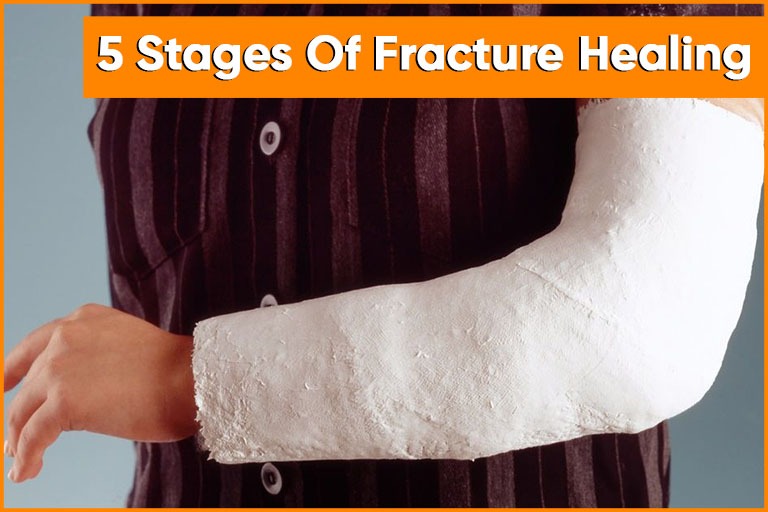The process of bone healing is amazing. Our skeleton, which is made up of stiff but flexible materials, supports us. Our bones enable us to move and support our lifestyle in a variety of ways, from dancing to simply lifting the laundry basket. However, when a bone breaks and the fracture healing process begins, it may seem as though everything has changed. How long will you have to go without having your normal range of motion? When will you be able to party all night long once more? Let’s examine the five stages of fracture healing so you’ll know what to anticipate and how to resume your normal activities as soon as possible after an injury.
Five Stages of Healing a Fracture
Your plans can be hampered by a broken bone at any time of year. You must keep the cast dry, and you probably won’t be able to do all of your usual strenuous activities. Here are the 5 phases of fracture healing you’ll go through if you or a loved one has fractured a bone.
First stage: Hematoma formation
When you are hurt, your body emits an internal alert. In the initial phase of fracture healing, the moment your cells learn about it, they immediately start working. On the surface, it may only appear that the site of your injury is swollen. On the inside, a well-orchestrated orchestra of cells is forming a clot—the good sort.
For want of a better term, your special cells known as the phagocytes begin consuming your undesired bacteria or pieces of bone that broke off from the fracture while the clot that forms around the crack covers the injury site. similar to your internal cleaning crew. For the first one to two weeks of your recovery, your body will keep up with this procedure.
Second stage: Development of fibrocartilaginous callus
Your bone healing process begins in stage two. Your white blood cells ought to have gotten rid of all the leftover bacteria and “debris” by this time. Your bones’ ends will now try to unite and stabilize one another. 4 to 21 days after your injury, this happens.
The process that is happening is very interesting. Your bone-producing cells are converting into bone cells so they may begin forming new bone tissue. A fracture callus is a term used to describe this tissue. You might need a cast for a time to safeguard it because it has to be protected because it is weak. This is because your bone starts to harden at each end and then moves toward the middle. This takes time and doesn’t happen instantly. Before moving on to stage 3, this stage can last one to two months. Your age, health, and the location of the fracture all affect how quickly your fracture will heal.
Third Stage: Development of bony calluses
Your soft fibrocartilaginous callus is replaced by a bony callus in the weeks that follow as your bones recover. There is numerous technical medical terminology used to indicate the formation of new bone, which is being strengthened by minerals taken from your body. When the callus hardens, you’ll be more like you were before the injury. Additionally, you’ll start to develop new blood vessels to support the growth. This process can happen any time between weeks 6 and 12 of the recovery following a fracture.
Fourth Stage: Bone remodeling
The fourth stage involves the breakdown of any additional bone that is developed to protect the area until it heals and returns to its normal shape by cells known as osteoclasts. They don’t work as swiftly as a construction crew would when demolishing a structure. It takes time because the process is slow.
The good news is that at this time, your bone is robust. Therefore, if you learn that the fourth stage of bone healing can take three to nine years, don’t be alarmed. You can carry on exactly as you did before the injury, albeit perhaps a little more cautiously. Although your damage may not have been your fault, you can change some aspects of your lifestyle to fortify your bones in case of a future catastrophe.
Fifth Stage: Bone support and recovery
The bone repair can be a difficult, drawn-out process. But it will all depend on how you manage your rehabilitation and continue to maintain your bones. In addition to bed rest and following your doctor’s advice, you can control your recovery by eating well, forming healthy lifestyle choices, and using a low-intensity pulsed ultrasound machine. You ought to:
- A healthy diet will provide your body with the necessary energy.
- Concentrate on getting enough protein, vitamins, and minerals. To ensure the optimum support for your bones, you’ll want to pay careful attention to your calcium and vitamin D intake.
- Avoid drinking and smoking while your fracture is healing.
- Think about including physical therapy or workouts that develop bones in your routine.
- For quicker healing, encourage protein synthesis and cell division.
It has been demonstrated that a LIPUS (low-intensity pulsed ultrasound) device can speed up the healing of new fractures by 38% and non-union fractures by 86%. As a result, you’ll return to normal sooner than someone who doesn’t take an active role in their bone recovery. To find out if this device can help you quickly return to your pre-injury lifestyle, get in touch with us.
